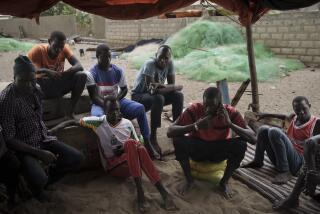BODY WATCH : Mental Attitude Is Half the Battle for Survival : Refugees: Food, water and warmth are crucial to the Cubans crossing 90 miles of empty ocean. But just as vital are an agile mind and the will to live.
- Share via
Cuban refugees with the best chance of surviving the 90-mile raft journey across the Florida Straits carry with them adequate supplies of food and water, some protection from the elements--and a healthy imagination coupled with a strong will to live.
“If someone decides to give up, they could die very quickly,” says Dr. Martin Nemiroff, a flight surgeon with the U.S. Coast Guard in Alameda, Calif., who has researched survival tactics and helped rescue more than 1,000 people.
In these situations, the ability to keep the mind occupied by such activities as telling jokes or daydreaming is crucial, he says, proving that survival under adversity tests both the physical and psychological limits of human endurance.
“A lot of these people are not in excellent physical condition when they start out,” adds Dr. James Wilkerson, a Merced pathologist and wilderness medicine expert. Their preparations may be haphazard; their supplies of food and water inadequate. The makeshift quality of the rafts makes the voyage even more dangerous, Wilkerson adds.
Mental activity could be especially crucial during the Cuba-to-United States crossing, Nemiroff says, because refugees see only sky and water for extended periods. Typical crossing times are three to five days, with 25% of refugees not surviving the trip, according to U.S. refugee aid organization estimates. (The exact number of dead is unknown.)
But the sensory deprivation can be combatted with mind games or daydreaming, Nemiroff says.
Even daydreaming about food, which might seem foolhardy, is helpful, Nemiroff says. He recalls a woman, shipwrecked in a remote part of Alaska, who had no idea it would take three weeks for her rescuers to find her. To keep herself occupied, she made mental lists of pizza toppings.
On a physical level, dehydration, sunburn and dangerously low body temperature (hypothermia) are the main problems faced by the refugees.
But even for the well-prepared, dehydration can occur quickly, within a day or even sooner, especially when the person is engaged in vigorous rowing or other activity. Refugees should be drinking two to three quarts of water a day.
Thirst is the first symptom of dehydration, sometimes followed by a rise in body temperature. In more advanced stages, there can be confusion and muscle cramps. Hallucinations, partially related to depletion of body minerals, can set in. Death can occur in a matter of hours, Nemiroff says.
Fluid replacement is vital. Almost any nonalcoholic liquid is suitable, Wilkerson says, including fruit juices, soft drinks and soups. Coffee, tea and hot chocolate are not ideal because they contain diuretic agents that will increase fluid loss, he says.
Drinking salt water is ill-advised, cautions Dr. Paul Auerbach, chief of the division of emergency medicine at Stanford University Medical School and a founder of the Wilderness Medical Society. Drinking a pint to a quart of salt water can cause nausea and vomiting, which can promote dehydration and lead to a condition called hypernatremia, in which the sodium content within the body becomes too high. Hypernatremia is characterized by delirium, seizures and, in profound cases, death. It can kill within 24 to 48 hours.
*
Sunburn can also occur quickly and set people up for hypothermia, a lower-than-normal body temperature that can be fatal. “When you are sunburned, you lose your ability to control body heat,” Nemiroff says. “You shiver.” Skin cools quickly when sunburned. If water is splashed on the skin--even if the water is warm--it can reduce body temperature further. Wind and wet clothing will cause it to decrease even more.
Hypothermia can occur in as little as two hours, affecting the very young and the elderly more quickly, Nemiroff says.
Mild hypothermia, generally defined as body temperatures of about 90 to 95 degrees, can be accompanied by a sensation of chilliness, skin numbness and minor impairment in muscular performance, along with shivering. “Once shivering stops, that’s an even more dangerous sign,” Nemiroff says, signaling progression to a more advanced stage of hypothermia.
In the most severe stages, there can be loss of consciousness, hallucinations and death.
Since the Cuban exodus began, Daniel Irwin, an emergency medical technician with the U.S. Coast Guard in Florida, has helped rescue about 350 refugees. “For the most part, their condition is good,” he says, “although they arrive with a lot of exposure problems.”
Even after participating in 1,000 rescues, Nemiroff can be awed by survivors’ grit. He recalls one man, not particularly physically fit, who jumped from a vessel, swam to shore, climbed a 100-foot cliff and crawled into a tree trunk, where he covered himself with sod to ward off the chill of the 32-degree night. “He was rescued the next day,” Nemiroff says.
His boat companion, a much more muscular man, had given up trying to get to safety--and had died.
More to Read
Sign up for Essential California
The most important California stories and recommendations in your inbox every morning.
You may occasionally receive promotional content from the Los Angeles Times.













